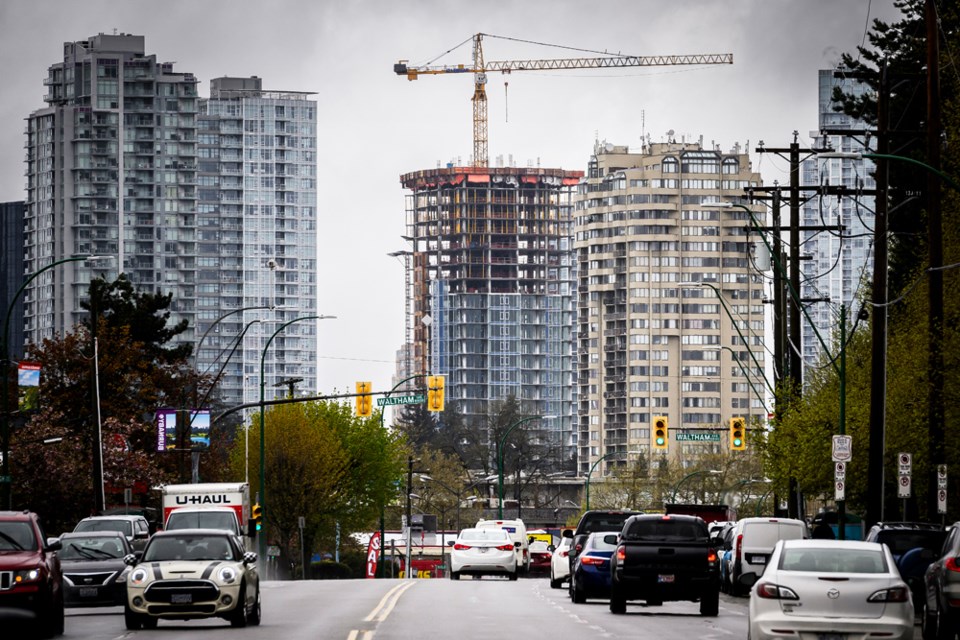The B.C. provincial agency overseeing worker safety is warning a boom in construction across the province is leading to increasingly risky crane operations.
According to WorkSafeBC, there are somewhere between 350 to 400 tower cranes currently operating in the province.
“WorkSafeBC has determined the risks associated with cranes in B.C. are increasing as more cranes are in operation than ever before, and work is taking place on increasingly complex, multi-employer worksites,” said the agency in a statement.
“The sheer size of the projects and the amount of activity taking place increases the risk profile.”
The statements were not attributed to an individual at the agency but were provided following inquiries by Glacier Media. They come after a series of high-profile accidents in recent years.
In 2021, a crane collapsed in downtown Kelowna, killing five people. Earlier this year, the RCMP completed its investigation into the incident, recommending a charge of criminal negligence causing death to be laid.
It's not clear who the charges would be laid against and WorkSafeBC said it wouldn’t release findings from the incident until the criminal matter is completed.
Between 2019 and 2023, WorkSafeBC issued a total of 13 penalties against B.C. crane operators for violating occupational health and safety regulations.
The penalties do not include the tragedy in Kelowna, or any other instances where cases are referred to Crown for potential prosecution under the Workers Compensation Act.
Yesenia Dhott, a spokesperson for WorkSafeBC, said penalties are reserved for the most significant violations and in cases where employers have been in “repeat noncompliance.”
Over the last two years, crane operators have faced a growing list of new regulations. Dhott said several of the penalties over the past five years involved cranes encroaching on high-risk zones, such as coming dangerously close to high-voltage power lines or overlapping with other tower cranes.
Since March 1, 2023, amendments to crane regulations require anti-collision devices to ensure safe distances from restricted areas.
But those measures appeared to fall short earlier this year. In February 2024, a crane load crashed to the ground at the multibillion-dollar Oakridge construction site in Vancouver, killing 41-year-old Yuridia Flores.
The next month, WorkSafeBC convened industry and labour representatives to identify gaps in safety. Some of the recommendations included reviewing how crane operators are certified, increasing staffing at WorkSafeBC, and updating occupational health and safety regulations so they keep up with “increasingly complex worksites.”
By Oct. 1, 2024, crane operators were required to undergo a formal supervised submission process when installing, repositioning or dismantling cranes.
Dhott said amendments are also underway to mandate the certification of tower cranes as safe for use by a professional engineer. They also propose to require inspection and certification of the major parts of a tower crane at least once every 12 months before being put into service.
As the independent provincial agency moves to tighten its regulatory grip, incidents involving construction cranes continue: the Vancouver Police Department shut down roads around an unstable crane in September, and another WorkSafeBC investigation into an unstable crane was launched last month when two beams fell to the ground along Hastings Street and Glen Drive, Global News first reported.
And in Burnaby, a construction company was fined after a worker — struck by a crane in 2023 — was told not to report the incident to WorkSafeBC.
A heavily redacted WorkSafeBC inspection report filed July 9, 2024, alleges Castores Builders Ltd. suppressed the claim from the worker at a commercial site off Lougheed Highway.
“The employer attempted to dissuade the worker from reporting their injury...” states the report.
The incident resulted in a $2,500 penalty.
With files from Colin Dacre



